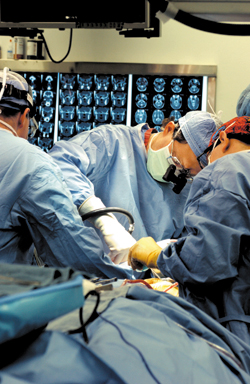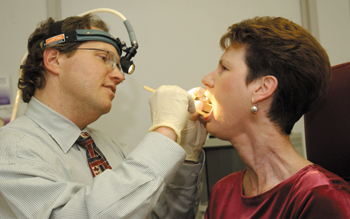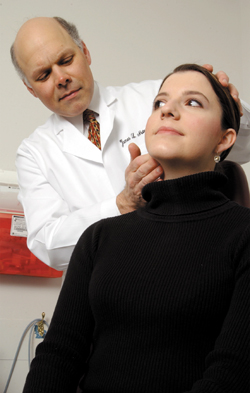
In a 10-hour surgery, Dr. Brian Burkey removed three malignant tumors that grew inside Tom Dickens’ face and neck, and, as much as possible, left his patient like he found him. (photo by Neil Brake)
Saving face — Head and neck cancer surgeons specialize in keeping patients, lives intact


Joan Lee, from Florence, Ala., is one of Burkey’s cancer patients who faced the numbers, and has been without incidence for two and a half years.(photo by Dana Johnson)

Patient care begins in clinic, says Dr. James Netterville, where surgeons make their first impressions on patients’ lives. (photo by Anne Rayner Pollo)
It’s Monday, four days since surgeons peeled back half of Tom Dickens’ face and spent 10 hours gingerly exploring the caverns behind his nose, extracting bits and pieces of tissue that’s not supposed to be there. He’s anxious to go home, jubilant to be breathing easily for the first time in almost two years, happier still to be leaving the hospital.
“I’m ready to sit in my recliner and lay in my own bed,” he says.
Dickens describes his visit summarily. “I had cancer in my sinuses,” he says, his demeanor calm if not bright, his voice almost lilting, as if to say, “Hey, did you hear about the fish I caught?”
He’s just taken his first shower since Thursday morning, and he says he feels like a real person again, although with the scars from his incision, along his nose and around his throat, sewn and stapled, he more closely resembles a stitched-up rag doll. His 14-year-old daughter put on a brave face when she saw him in the recovery room, still swollen from the ordeal. Then, outside the room, she broke apart. “She said, ‘That’s not my daddy,’” Dickens’ wife, Kim Dickens, says. She and Tom married 14 years ago. They split up, stayed in touch, and remarried after 10 years, on Valentine’s Day, a week before Tom’s surgery. “I had a lot of healing to do,” Tom says. “But we healed the marriage first.”
Outside major academic medical centers such as Vanderbilt, in small towns all across America, otolaryngology is a medical specialty propagated, generally, by ear tubes for kids and snoring solutions for adults.
But at the Vanderbilt Bill Wilkerson Center for Otolaryngology and Communication Sciences, especially, a team of otolaryngologists focuses on working beneath the very parts of us that project our human character, going behind our grins, our chubby or angular cheeks, our petite or prominent noses, to cut out what could be killing us.
Often, their patients face not only a life-threatening, and certainly life-altering disease, but they face social isolation, because they’ve smoked or dipped or chewed tobacco, which might have sparked their tumorous growths. Some, like Dickens, have no risk factors, yet still face scrutiny by insurance companies for being in the company of patients whose behaviors are linked to cause.
And then there’s the surgery. Generally regarded as grueling, demanding, surgeons maneuver around nerves that control the face or sight or hearing, work around major arteries that feed our brains, around bones, joints and muscles that allow us to eat or breathe—basically operating on a microcosm of the body.
That’s also what makes it interesting.
“It excites people about the field, to open up the head or neck and see major anatomy that we learned in Gray’s text,” says Dr. Brian Burkey, associate professor of Otolaryngology, director of the department’s residency program and Dickens’ surgeon. “If you like a challenge, it’s kind of fun. You’re on the edge, in figurative terms. We never know exactly what we’re going to have to do going in. That attracts people to it,” he says.
Surgical oncologists began ceding cancers of the head and neck to otolaryngologists back in the 1950s. Now, about 90 percent of head and neck cancer cases go to otolaryngologists. Burkey, Dr. James Netterville, professor and assistant director of the Vanderbilt Bill Wilkerson Center for Otolaryngology and Communication Sciences who has been at Vanderbilt since 1986, and Dr. Stephen Bayles, assistant professor of Otolaryngology, here since 2000, see the majority of head and neck cancer cases in Middle Tennessee. Some patients live in neighborhoods near the medical center, some hundreds of miles away.
The Dickens live in Mt. Juliet. Tom works as a construction coordinator for a cable TV company. One day, in 2000, his nose started bleeding and wouldn’t stop. He and Kim went to the closest emergency room, where a physician told him he had a deviated septum and packed his nose. The next morning, Kim says, his nose was bleeding through the packing.
For a year and a half he was treated for recurring sinus infections, and he waited for surgery to correct that deviated septum. “We had no idea his face was eaten up with cancer,” Kim says.
But after another non-stop nose bleed, he sought a second opinion, from Dr. Grady Lee Bryant Jr., an otolaryngologist who graduated from medical school at Vanderbilt in 1992 and finished his otolaryngology residency here in 1998. Bryant ordered imaging scans, biopsied the mass in Dickens’ nose and gave him the diagnosis. “Dr. Bryant made an appointment for me to see Dr. Burkey at 10 the next morning. He told me not to wait, to go see him,” Dickens says.
The next morning, Jan. 31, Burkey peers for the first time at Dickens’ tumor through a nasopharyngoscope, a fiber optic endoscope with an attached camera that’s snaked through the nostril. On black-and-white CT and MRI films, the mass looks like a small white egg squeezed into sinuses behind his left nostril. Two other masses, unrevealed until now, show up, one at the base of his tongue and another at the very back of the cavern behind his face, at the base of his skull.
To reach the tumor behind Dickens’ sinus, and to explore up to the base of the skull, Burkey, otolaryngology fellow Dr. Bill Magdycz, and fourth-year resident Dr. Brian Moore remove part of the cheek bone, like taking off the air filter on a ‘78 Camaro to work on the carburetor. Then they fit a steel plate over the gap, screw it in, remove it and set it aside. When they exit the site, they return the plate, and the symmetry in Dickens’ face.
“Surgeons at some medical centers would have taken the entire bone out as a specimen, leaving the patient’s face looking sunken in,” Burkey says.
Recent advances in head and neck cancer surgery aim at preserving form and function—being more aggressive about leaving body parts than taking them out.
Other preservative innovations Burkey, Bayles and Netterville regularly employ include microvascular reconstruction, a method of autotransplantation—using tissue from another part of the body that has characteristics similar to tissue that needs to be removed. For instance, replacing tissue from partial tongue resections with the thin skin from the forearm. Also, when possible, they work to preserve tissues near the tumor, but which are not directly involved, such as preserving the larynx, the voice box that contains the vocal folds, the thin tissue doors that vibrate to produce speech and close when swallowing to keep what’s been in your mouth from going into your lungs. If the larynx is removed, surgeons have to create a permanent tracheostomy, a hole in the throat that requires constant upkeep to prevent infection and appliances to produce mechanical-sounding speech.
“People used to say you had to take the whole larynx,” Burkey says. “We’ll take maybe two-thirds to three-fourths, and save the rest so the patient can still speak and swallow. That’s why people come to Vanderbilt, for that kind of care.”
Surgery begins not in the OR, but, Netterville says, at the first meeting between patients and surgeons. “We’re like a family,” he says. “We have an extraordinary opportunity to make a difference in these people’s lives, in their families’ lives, by treating their cancer.”
He keeps photos on his computer from a recent visit he made to a patient’s home woodshop, grinning at handmade rocking chairs. Folks call him “Jimmy” with regularity. “People send us gifts, telling us how grateful they are for the care we gave them,” he says.
In clinic, Burkey moves between exam rooms, scoping patients, looking up noses, flashing his fiber optic light beyond tonsils. The patients who are back for follow-up hail him as a conquering hero, the man who removed the cancer and saved her tongue, or kept his voice box.
Dickens remembers seeing Burkey for the first time, the morning after Bryant told him he had cancer, after a fitful night wrestling with his newly identified foe. “I felt at ease talking to Dr. Burkey, even after he discussed all the possibilities,” Tom says.
In the OR, Burkey removes the tumor from Dickens’ sinus and collects bits of suspect tissue, which he hands to the scrub nurse with directions to label them according to geography—“medial sinus,” “skull base” and such. They’re sent to pathology, and about an hour later an intercom crackles with the report.
First, the skull base tumor. If it’s malignant, a neurosurgeon, on standby, will enter the room to open Dickens’ skull and pull back his brain to explore for more growths. But the tumor was benign, the pathologist says, just normal tissue. Burkey lets out a “yes!” and pumps his fists.
Then the sinus tumor. “Invasive squamous cell carcinoma.”
Several hours later, Burkey resects the lump at the base of Dickens’ tongue and metastatic cancer in the lymph nodes of his neck. These pathology reports, too, are positive; invasive squamous cell carcinoma.
Afterward Dickens’ head clears of anesthesia, Burkey talks to him and Kim. Dickens knew going into the operation that his body was growing cancerous cells. He knew that although polyps in the nose and sinuses are not uncommon, only about 2 percent of those growths become cancerous. The surgeon brings up what most people want to know, their odds at beating cancer.
“I always tell people, when we talk about the numbers and their faces drop, that I try to be fairly realistic, but hopeful,” Burkey says. In Dickens’ case, 20 percent of patients live to 5 years after treatment. But, Burkey says, there’s no need to dwell on the odds. “For him, it’s zero or 100—either he lives or he doesn’t. He’s alive right now, and that’s what he should be concerned about.” He mentions that several of the patients he saw in clinic the other day, the ones happy to drive from Florence, Ala., and Kingsport, Tenn., every six months for years to wait to see him and have their noses and throats examined, they had similar odds.
As he waits to be sent home, Dickens, a man of strong religious conviction who says he couldn’t imagine going through this without God, shows every sign of a man loving the time allotted him. He rejoices in small triumphs, like the non-cancerous tissue on his skull. “I’m the guy who always sees the glass half-full,” he says. Kim says, “It’s a miracle that he can breathe again.”
In six weeks he’ll begin radiation treatments at Vanderbilt-Ingram Cancer Center. Right now, though, he says, having cancer “is just a journey we have to go through.”
And, like his marriage to Kim, he sees himself healed, at least for the time being, with a new chance at life.













